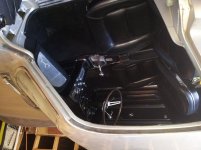JamesWeber
Member
Hi, I just joined today. My Mom gave me her 1965 Stingray that has been in storage for about 30 years. I am trying to complete the install of a pertronix 2 ignition and flame thrower 2 coil. I am beginning to feel like I just bought a used boat. $$$$  )
)
Anyway, I have attached the new 12 gauge wire to the positive coil terminal and strung it through the firewall. I removed the seat, and I am now performing gymnastic contortions to reach the ignition switch. My question is how to best attach the wire to the switch without creating any problems?
I don't suppose anyone has any pictures to help with this final step of the install?
Thanks.
Anyway, I have attached the new 12 gauge wire to the positive coil terminal and strung it through the firewall. I removed the seat, and I am now performing gymnastic contortions to reach the ignition switch. My question is how to best attach the wire to the switch without creating any problems?
I don't suppose anyone has any pictures to help with this final step of the install?
Thanks.






